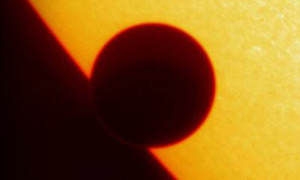 In a recent press release, award-winning and leading telescope and optics manufacturer Celestron, announced the release of two new solar observing telescope packages, priced under $100. The release and promotion is aimed at those who want a safe way to view the upcoming solar eclipse of the Sun on May 20th and then see the transit of Venus across the face of the Sun on June 5th and 6th.
In a recent press release, award-winning and leading telescope and optics manufacturer Celestron, announced the release of two new solar observing telescope packages, priced under $100. The release and promotion is aimed at those who want a safe way to view the upcoming solar eclipse of the Sun on May 20th and then see the transit of Venus across the face of the Sun on June 5th and 6th.
During the upcoming solar eclipse on Sunday evening, for those in the western United States, the Moon will create a near full eclipse of the sun as it moves in front of the Earth’s nearest star. Although the moon will cover over 90% of the Sun’s diameter during the event, looking at the eclipse with the naked eye would still result in severe eye damage.
In an earlier article (Solar Eclipse Sunday) we talked about using a projection method to see the eclipse or for observing the sun in general. The other option, providing more direct viewing of the sun is to use a telescope with specially designed and tested sun filters.
Another rare event for amateur astronomers will be the opportunity to watch the planet Venus as it makes a transit, passing in front of the Sun. According to experts this is among the rarest of planetary alignments, and will be visible on June 5th and 6th. The Venus transit, visible across western North America and Hawaii,will be the last such viewing opportunity for over 100 years.
According to Celestron, “Only six transits of Venus have happened since the invention of the telescope. Occurring in pairs, with eight years separating the two events and more than a century between the pair of transits. The first transit of this century’s pair took place in June 2004, prior to that the last transit was in December 1882 and the next transit will not take place until December 2117! This is a very rare event and should not be missed!”
To celebrate these extraordinary astronomical events, Celestron has unveiled 2 new solar edition telescope packages. The scopes make solar observations, including sun spots, both easy and safe. The removable sun filters in the Solar Observer 60 and Solar Observer 70 allow users to observe the sun during the day and then transition to star-gazing at night.
The Solar Observer 60 Telescope is an easy to use and transport 60 mm telescope, with solar filter and full-height tripod and retails for $79.95. The Solar Observer 70 Telescope also features a 60 mm aperture telescope along with full-height tripod and solar filter, but his model is designed for easy transport by fitting inside the custom backpack, and retails for $99.95.
“These grand celestial events are rare and magnificent to behold,” said Celestron CEO, Joseph A. Lupica, Jr. “Encouraging the public to experience these events provides Celestron with the opportunity to accomplish its mission; to educate and inspire people to look up and enjoy the sky.”
![Herbal Reference Substances are Key to Everyday Products <!-- AddThis Sharing Buttons above -->
<div class="addthis_toolbox addthis_default_style " addthis:url='http://newstaar.com/herbal-reference-substances-are-key-to-everyday-products/3512112/' >
<a class="addthis_button_facebook_like" fb:like:layout="button_count"></a>
<a class="addthis_button_tweet"></a>
<a class="addthis_button_pinterest_pinit"></a>
<a class="addthis_counter addthis_pill_style"></a>
</div>When it comes to quality control testing and the development of new products, Botanical Reference Materials (BRMs), also known as Herbal References are critically important. To help companies ultimately obtain all-important FDA approval, the Food and Drug Administration provides in its guidance a recommendation that […]<!-- AddThis Sharing Buttons below -->
<div class="addthis_toolbox addthis_default_style addthis_32x32_style" addthis:url='http://newstaar.com/herbal-reference-substances-are-key-to-everyday-products/3512112/' >
<a class="addthis_button_preferred_1"></a>
<a class="addthis_button_preferred_2"></a>
<a class="addthis_button_preferred_3"></a>
<a class="addthis_button_preferred_4"></a>
<a class="addthis_button_compact"></a>
<a class="addthis_counter addthis_bubble_style"></a>
</div>](http://newstaar.com/wp-content/uploads/2021/02/Achillea_millefolium_flowers-100x100.jpg)
![Quality Electrochemical Biosensors are Critical for Medical, Food and Chemical Industry <!-- AddThis Sharing Buttons above -->
<div class="addthis_toolbox addthis_default_style " addthis:url='http://newstaar.com/quality-electrochemical-biosensors-are-critical-for-medical-food-and-chemical-industry/3512086/' >
<a class="addthis_button_facebook_like" fb:like:layout="button_count"></a>
<a class="addthis_button_tweet"></a>
<a class="addthis_button_pinterest_pinit"></a>
<a class="addthis_counter addthis_pill_style"></a>
</div>A number of industries have, at their core, a need to frequent or even continuous analysis of biological media. These include the medical and pharmaceutical fields, biotech firms, and food and chemical companies. To maintain quality standards and develop new products, these industries rely heavily […]<!-- AddThis Sharing Buttons below -->
<div class="addthis_toolbox addthis_default_style addthis_32x32_style" addthis:url='http://newstaar.com/quality-electrochemical-biosensors-are-critical-for-medical-food-and-chemical-industry/3512086/' >
<a class="addthis_button_preferred_1"></a>
<a class="addthis_button_preferred_2"></a>
<a class="addthis_button_preferred_3"></a>
<a class="addthis_button_preferred_4"></a>
<a class="addthis_button_compact"></a>
<a class="addthis_counter addthis_bubble_style"></a>
</div>](http://newstaar.com/wp-content/uploads/2020/10/Electrochemical-Biosensor-100x100.jpg)
![Company Develops Industrial Mixers Well-Suited for both Fragile and Explosive Products <!-- AddThis Sharing Buttons above -->
<div class="addthis_toolbox addthis_default_style " addthis:url='http://newstaar.com/company-develops-industrial-mixers-well-suited-for-both-fragile-and-explosive-products/3512071/' >
<a class="addthis_button_facebook_like" fb:like:layout="button_count"></a>
<a class="addthis_button_tweet"></a>
<a class="addthis_button_pinterest_pinit"></a>
<a class="addthis_counter addthis_pill_style"></a>
</div>Industrial drum mixers are normally applied to blend mixes of varying viscosities such as adhesive slurries or cement. Some of these mixers have the capability of blending mixes of very different particle sizes such as fruit and ice cream, and gravel and cement slurry. The […]<!-- AddThis Sharing Buttons below -->
<div class="addthis_toolbox addthis_default_style addthis_32x32_style" addthis:url='http://newstaar.com/company-develops-industrial-mixers-well-suited-for-both-fragile-and-explosive-products/3512071/' >
<a class="addthis_button_preferred_1"></a>
<a class="addthis_button_preferred_2"></a>
<a class="addthis_button_preferred_3"></a>
<a class="addthis_button_preferred_4"></a>
<a class="addthis_button_compact"></a>
<a class="addthis_counter addthis_bubble_style"></a>
</div>](http://newstaar.com/wp-content/uploads/2020/06/bandeau-sofragir2-100x100.jpg)